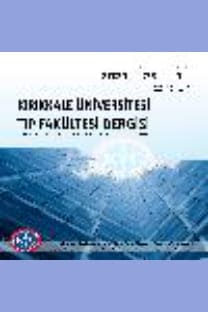Kırıkkale Yöresinde İnsan ve Hayvan Kaynaklarından İzole Edilen E. coli O157:H7’nin Prevalansı
Escherichia coli, ELISA, seroprevalans, insan, sığır, ELISA
PREVALENCE OF E. coli O157:H7 ISOLATED FROM HUMAN AND ANIMAL SOURCE IN KIRIKKALE PROVINCE
Escherichia coli, seroprevalence, human, cattle, ELISA, ELISA,
___
- 1. Chattaway MA, Dallman T, Okeke IN, Wain J. Enteroaggregative E. coli O104 from an outbreak of HUS in Germany 2011, could it happen again? J Infect Dev Ctries. 2011;5(6):425-36.
- 2. Rubino S, Capuccinelli P, Kelvin DJ. Escherichia coli (STEC) serotype O104 outbreak causing haemolytic syndrome (HUS) in Germany and France. J Infect Dev Ctries. 2011;5(6):437-40.
- 3. Riley LW, Remis RS, Helgerson SD, McGee HB, Wells JG, Davis BR et al. Hemorrhagic colitis associated with a rare Escherichia coli serotype. N Engl J Med. 1983;308(12):681-5.
- 4. Riley LW. The epidemiological, clinical and microbiological features of hemorrhagic colitis. Ann Rev Microbiol. 1987;41:383-407.
- 5. Jackson SA, Patel IR, Barnaba T, LeClerc JE, Cebula TA. Investigating the global genomic diversity of Escherichia coli using a multi-genome DNA microarray platform with novel gene prediction strategy. BMC Genomics. 2011;12:349.
- 6. Ravva SV, Sarreal CZ, Mandrell RE. Identification of protozoa in dairy lagoon wastewater that consume Escherichia coli O157:H7 preferentially. PLoS One. 2010;5:e15671.
- 7. Griffin PM, Tauxe RV. The epidemiology of infections caused by Escherichia coli O157:H7, other enterohemorrhagic Escherichia coli and associated hemolytic uremic syndrome. Am J Epidemiol. 1991;13:60-98.
- 8. Bopp CA, Brenner FW, Wells JG, Strockbine AA. Escherichia, Shigella and Salmonella. In: Murray PR, Baron EJ, Jorgensen JH, Pfaller MA, Yolken RH, eds. Manual of Clinical Microbiology. 7th ed. Washington D.C. AMS Press, 2003:654-71.
- 9. Karmali MA, Petric M, Lim C, Flemming PC, Arbus GS, Lior H. The association between idiopathic hemolytic uremic syndrome and infection by verotoxin producing Escherichia coli. J Infect Dis. 1985;151(5):775-82.
- 10. Hascelik G, Akan OA, Diker S, Baykal M. Campylobacter and Enterohemorrhagic Escherichia coli associated gastroenteritis in Turkish children. J Diarrheal Dis Res Dec. 1991;9(4):315-7.
- 11. Amisano G, Fornasero S, Migliaretti G, Caramello S, Tarasco V, Savino F. Diarrheagenic Escherichia coli in acute gastroenteritis in infants in north-west Italy. New Microbiologica. 2011;34(1):45-51.
- 12. Käppeli U, Hächler H, Giezendanner N, Beutin L, Stephan R. Human infection with non-O157 shiga toxin-producing Escherichia coli, Switzerland, 2000-2009. Emerg Infect Dis. 2011;17(2):180-5.
- 13. Chigor VN, Umoh VJ, Smith SI, Igbinosa EO, Okoh AI. Multidrug resistance and plasmid patterns of Escherichia coli O157 and other E. coli isolated from diarrhoeal stools and surface waters from some selected sources in Zaria, Nigeria. Int J Environ Res Public Health. 2010;7(10):3831-41. 14. Inat G, Siriken B. Detection of Escherichia coli O157 and Escherichia coli O157:H7 by the immune-magnetic separation technique and stx1and stx2 genes by multiplex PCR in slaughtered cattle in Samsun province, Turkey. J Vet Sci. 2010;11(4):321-6.
- 15. Ahmed AM, Shimamoto T. Molecular analysis of multidrug resistance in Shiga toxin-producing Escherichia coli O157:H7 isolated from meat and dairy products. Int J Food Microbiol. 2015;193:68-73.
- 16. Hessain AM, Al-Arfaj AA, Zakri AM, El-Jakee JK, Al-Zogibi OG, Hemeg HA et al. Molecular characterization of Escherichia coli O157:H7 recovered from meat and meat products relevant to human health in Riyadh, Saudi Arabia. Saudi J Biol Sci. 2015;22(6):725-9.
- 17. Abdissa R, Haile W, Fite AT, Beyi AF, Agga GE, Edao BM et al. Prevalence of Escherichia coli O157:H7 in beef cattle at slaughter and beef carcasses at retail shops in Ethiopia. BMC Infect Dis. 2017;17(1):277.
- 18. Chapman PA, Siddons CA, Cerdan Malo AT, Harkin MA. A 1 year study of Escherichia coli O157 in raw beef and lamb products. Epidemiol Infect. 2000;124(2):207-13.
- 19. Yin X, Zhu J, Feng Y, Chambers JR, Gong J, Gyles CL. Differential gene expression and adherence of Escherichia coli O157:H7 in vitro and in ligated pig intestines. PLoS One. 2011;6(2):e17424.
- 20. Easton DM, Totsika M, Allsopp LP, Phan MD, Idris A, Wurpel DJ et al. Characterization of EHaJ, a new autotransporter protein from enterohaemorrhagic and enteropathogenic Escherichia coli. Front Microbiol. 2011;2:e120.
- 21. Sperandio V. Sdi A sensing of acyl-homoserine lactones by enterohemorrhagic E. coli (EHEC) serotype O157:H7 in the bovine rumen. Gut microbes. 2010;1(6):432-5.
- ISSN: 2148-9645
- Yayın Aralığı: Yılda 3 Sayı
- Başlangıç: 1999
- Yayıncı: KIRIKKALE ÜNİVERSİTESİ KÜTÜPHANE VE DOKÜMANTASYON BAŞKANLIĞI
SEVAL BAYRAK, GÜLBAHAR USTAOĞLU, Emine Şebnem KURŞUN ÇAKMAK, CEMAL ATAKAN
KARIN AĞRISININ NADİR BİR NEDENİ: APENDİKS MUKOSEL OLGU SUNUMU
Faruk PEHLİVANLI, Gökhan KARACA, Çağatay Erden DAPHAN, Anıl Oğuz EROĞLU, Sevilay VURAL, Figen COŞKUN
Ufuk CAKIR, CÜNEYT TAYMAN, Mehmet BÜYÜKTİRYAKİ
ANNELERİN SÜT DİŞLENME İLE İLGİLİ BİLGİ VE DENEYİMLERİNİN DEĞERLENDİRİLMESİ
Ektodermal Displazili Çocuklarda Erken Protetik Tedavi: Üç Olgu Sunumu
FATİH TULUMBACI, Tuğba SERT, MERVE ERKMEN ALMAZ
HASTANELERDE SÜRVEYANS BİRİMİNİN KURULMASININ BULAŞICI HASTALIK BİLDİRİMLERİ ÜZERİNE ETKİSİ
Aslı HAYKIR SOLAY, Saadet ÜNSAL, Ali ACAR, Yunus GÜRBÜZ, Fatma ESER, Gülnur KUL, İrfan ŞENCAN
Erden ATİLLA, Fulya ÖZEL, Pınar ATACA ATİLLA, PERVİN TOPÇUOĞLU, HAMDİ AKAN, MERAL BEKSAÇ, OSMAN İLHAN, MUHİT ÖZCAN, Önder ARSLAN, GÜNHAN GÜRMAN, Selami KOÇAK TOPRAK
BI-RADS5 Meme Lezyonlarında Sonoelastografinin Tanısal Yeri
Rasime Pelin KAVAK, Nezih KAVAK, Savaş BABA, Murat Özgür KILIÇ, Gül DAĞLAR
ALIŞILMADIK BİR LAVMAN UYGULAMASINA BAĞLI REKTOSİGMOİD İSKEMİ VE PERFORASYON
